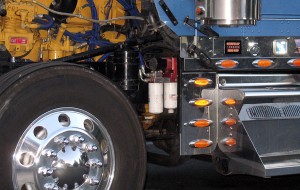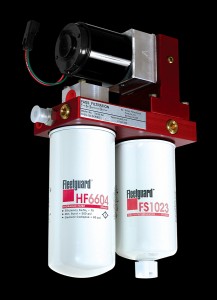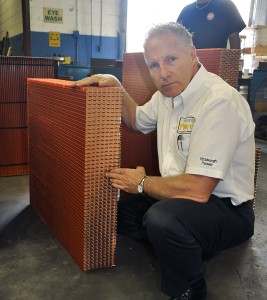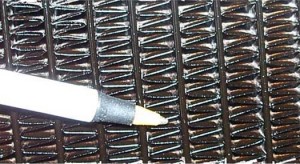 We often talk about the importance of adequate air, fuel and exhaust flow in your engine, and continue to learn more about it while testing trucks on our new Taylor Dyno. For instance, our ported and ceramic-coated exhaust manifold flows 20% more exhaust, lowers the exhaust temperature by 125 degrees, and improves the spool-up time of the turbocharger, in addition to a .25 mpg increase in fuel mileage! What we have recently learned on the C-15 Caterpillar single turbo engines is that the manifold, when coupled with our high-performance Cat turbo, gains the engine about 100 horsepower.
We often talk about the importance of adequate air, fuel and exhaust flow in your engine, and continue to learn more about it while testing trucks on our new Taylor Dyno. For instance, our ported and ceramic-coated exhaust manifold flows 20% more exhaust, lowers the exhaust temperature by 125 degrees, and improves the spool-up time of the turbocharger, in addition to a .25 mpg increase in fuel mileage! What we have recently learned on the C-15 Caterpillar single turbo engines is that the manifold, when coupled with our high-performance Cat turbo, gains the engine about 100 horsepower.
In the coming months, we will have concrete “before-and-after” dyno test results that will tell us exactly just how much horsepower increase these changes result in for each engine, but as for now, our customer feedback has given us a pretty good idea. We are NOT adding any additional fuel – just eliminating restriction and turbulence. The net gain is 3.12 horsepower PER POUND of turbo boost. That is an incredible gain of power by simply changing only two items on the engine (the manifold and turbo). Please keep in mind that these trucks that we test already have our high-flow Quiet Performance mufflers, and most of them also have Fleet Air filters already installed.
 Every day we get phone calls from owner-operators that have installed the manifold and turbo at the same time and many of them have told us that they have to learn how to drive their engines all over again because of the power, rate of acceleration, and responsiveness. During the Louisville truck show last month, an owner-operator told me he installed the Fleet Air filter and our Quiet Performance muffler on his truck and gained 1/2 mile per gallon. His total investment of $518 was paid off in the first two weeks of driving. So, what that means is that every two weeks, for the life of his truck/engine, he is going to make $518 more than he did before! When people say that they can’t afford high-performance upgrades, I think to myself, “You can’t afford NOT to buy them!” Again, it’s all about the flow of air, fuel and exhaust.
Every day we get phone calls from owner-operators that have installed the manifold and turbo at the same time and many of them have told us that they have to learn how to drive their engines all over again because of the power, rate of acceleration, and responsiveness. During the Louisville truck show last month, an owner-operator told me he installed the Fleet Air filter and our Quiet Performance muffler on his truck and gained 1/2 mile per gallon. His total investment of $518 was paid off in the first two weeks of driving. So, what that means is that every two weeks, for the life of his truck/engine, he is going to make $518 more than he did before! When people say that they can’t afford high-performance upgrades, I think to myself, “You can’t afford NOT to buy them!” Again, it’s all about the flow of air, fuel and exhaust.
Speaking of fuel flow, fuel lines need to be changed once they are about 10 years old. Around that time, the rubber on the inside of the hose will begin to swell closed, thus restricting the fuel flow. The best item you can install for your engine’s fuel flow is the FASS (Fuel Air Separation System). During the installation, some of the fuel lines will need to be replaced, so just replace them all and eliminate the chance of fuel starvation. Diesel fuel has between 3% and 10% air. The harder the fuel pump has to work to suck the fuel out of the tank and then pressurize it into the fuel pump or the injectors, the more air it extracts out of the fuel. This air has to be compressed in the injector first, and then the fuel second, before ignition begins. This delays the timing and forces the ECM to change it constantly. The injectors are looking for fuel, but the air comes first – and now the timing is off.
 The ECM could compensate for the delayed timing if all of the injectors received the same amount of air every time, but they don’t. Why not just eliminate the air in the fuel by installing a FASS unit? When running a FASS, the fuel pump does not have to suck the fuel out of the tank – the electric motor on the FASS does that job, along with eliminating the air from the fuel, and then pushing the fuel under pressure to the fuel pump. The fuel pump loves the positive pressure because the hardest part of its job has just been eliminated. Now, all the fuel pump has to do is increase the pressure and push it into the injectors. The net results are many: the life of the fuel pump is greatly extended; the horsepower of the engine improves by about 30 hp; the fuel mileage improves by about .3 mpg; the throttle response improves; the injectors live longer (because the “tapping” effect caused by air bubbles at the tips is gone); the engine runs a lot smoother (especially the BXS Acerts); and the pull of the engine is much more consistent. That’s seven, yes seven, major improvements by installing just one item on your engine! That’s a good deal.
The ECM could compensate for the delayed timing if all of the injectors received the same amount of air every time, but they don’t. Why not just eliminate the air in the fuel by installing a FASS unit? When running a FASS, the fuel pump does not have to suck the fuel out of the tank – the electric motor on the FASS does that job, along with eliminating the air from the fuel, and then pushing the fuel under pressure to the fuel pump. The fuel pump loves the positive pressure because the hardest part of its job has just been eliminated. Now, all the fuel pump has to do is increase the pressure and push it into the injectors. The net results are many: the life of the fuel pump is greatly extended; the horsepower of the engine improves by about 30 hp; the fuel mileage improves by about .3 mpg; the throttle response improves; the injectors live longer (because the “tapping” effect caused by air bubbles at the tips is gone); the engine runs a lot smoother (especially the BXS Acerts); and the pull of the engine is much more consistent. That’s seven, yes seven, major improvements by installing just one item on your engine! That’s a good deal.
Summer is coming and so it the hot weather. If your radiator is old and just getting you by, please take care of it now before it’s an emergency. Here’s something to think about concerning radiators: the first two rows do the majority of the cooling, and the next two rows help a little more. If you purchase a five or six row radiator, it’s still only the first four rows that do the cooling. This is why we install 100 tubes per row in our radiators for 379 Peterbilts (the KW has a narrower hood so their radiators have even more tubes per row). It’s the amount of tubes per row and the amount of fins per inch, along with dimpled tubes, that makes a radiator great – not how many rows of tubes.
 On a final note, if you are bringing your truck into our shop, do yourself a favor and write down everything that is wrong with the truck. Don’t try to remember everything – take the time to write them down, because when you are standing at the counter and we are writing your work order, items are forgotten. Too often we hear, once the job is completed, “By the way, did you notice that my fan is not working all the time,” or “My coolant temperature fluctuates.” At this point, we have completed all of the repairs you told us were needed, but now there are more and the day is over. If you have any comments or questions, I can be contacted through Pittsburgh Power Inc. in Saxonburg, PA by calling 724-360-4080 or via e-mail at bruce@pittsburghpower.com.
On a final note, if you are bringing your truck into our shop, do yourself a favor and write down everything that is wrong with the truck. Don’t try to remember everything – take the time to write them down, because when you are standing at the counter and we are writing your work order, items are forgotten. Too often we hear, once the job is completed, “By the way, did you notice that my fan is not working all the time,” or “My coolant temperature fluctuates.” At this point, we have completed all of the repairs you told us were needed, but now there are more and the day is over. If you have any comments or questions, I can be contacted through Pittsburgh Power Inc. in Saxonburg, PA by calling 724-360-4080 or via e-mail at bruce@pittsburghpower.com.
